Electric kettles are a popular and essential kitchen item in most households, from making a quick cuppa to warming water fast for any other use.
Sadly, kettles develop limescale deposits over time, resulting in unsightly stains.
If not properly removed, this can lower the performance of the appliance. Luckily, cleaning the lime scale is not hard if you know how to do it.
All you need is to use easily available solutions. Read on to learn what limescale is, how to remove it from the kettle, and a few other tips.
Use easily available acid-based cleaning solutions to remove limescale. For example, vinegar is an excellent cleaning agent that dissolves the caked lime, restoring the original stainless steel sparkle.
Others include; lemon juice, Coca-Cola, and baking soda, among others.
What Is Limescale?
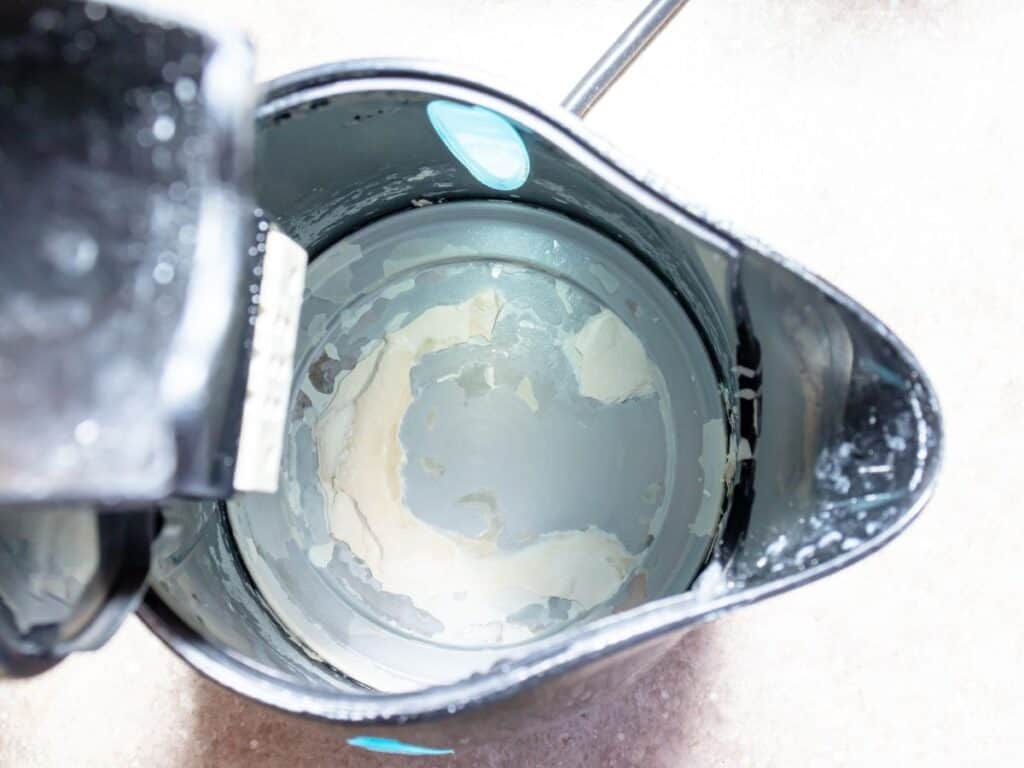
Before starting to remove limescale from the kettle, it is helpful to first understand what it is, so you can know how to deal with it.
Limescale refers to calcium carbonate deposits primarily found in areas of hard water with high concentrations of calcium and magnesium ions.
Limescale is the same substance you see, coating sections of a slowly leaking pipe as the water evaporates.
This is the same chemical that builds up in the kettle over time, forming a hard coating. Contrary to some beliefs, other than the unpleasant taste in your beverage, it is entirely harmless healthwise.
But that aside, the coating disfigures the kettle and may reduce its performance and durability.
Removing Limescale With Vinegar
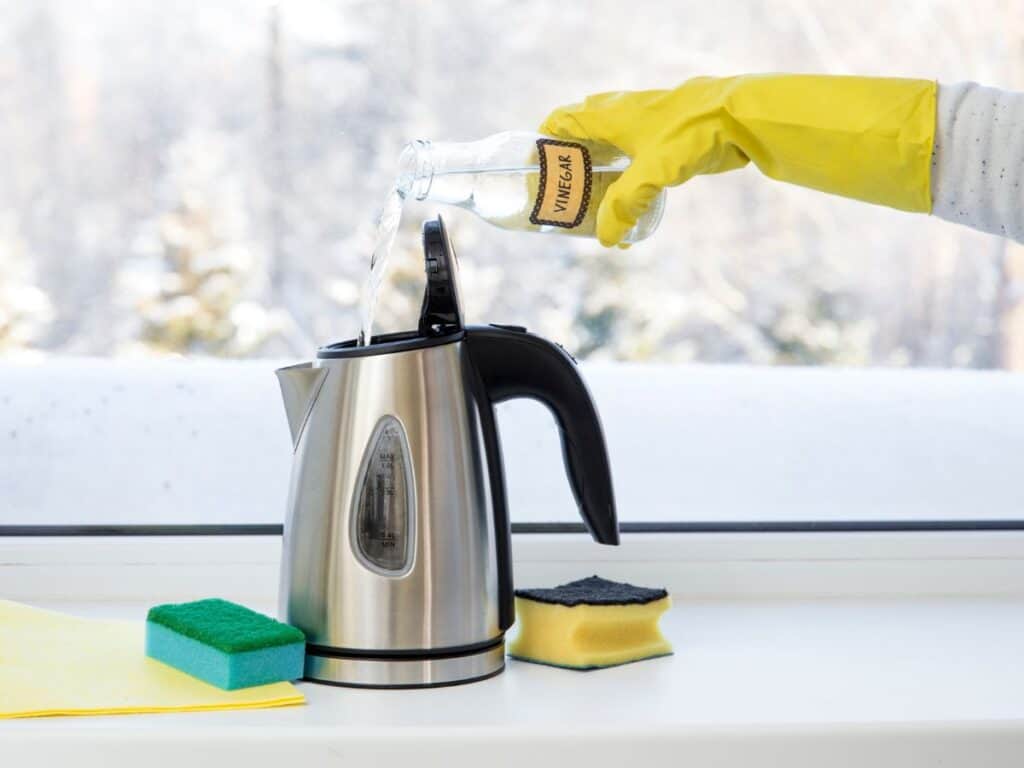
Vinegar is a versatile substance with many other uses around our homes. A mildly acidic substance, it is a cheap but effective cleaning agent easily obtainable from your nearest convenience store.
To remove lime from the kettle, measure equal part vinegar to the water in the kettle and fill the water halfway to create a solution.
Next, heat the solution to the boiling point before letting it sit for 1 hour to cool off. After this period, discard the solution and rinse.
This should remove most of the limescale, but you can use a sponge or a brush to clear off the residues completely.
However, remember, depending on the severity, you might require to repeat the process several times.
Once this stage is done, add water into the kettle and heat it again to the boiling point to remove vinegar residues.
Finally, you can rinse it off with clean water, and the kettle is ready for use.
Cleaning With Citric Acid
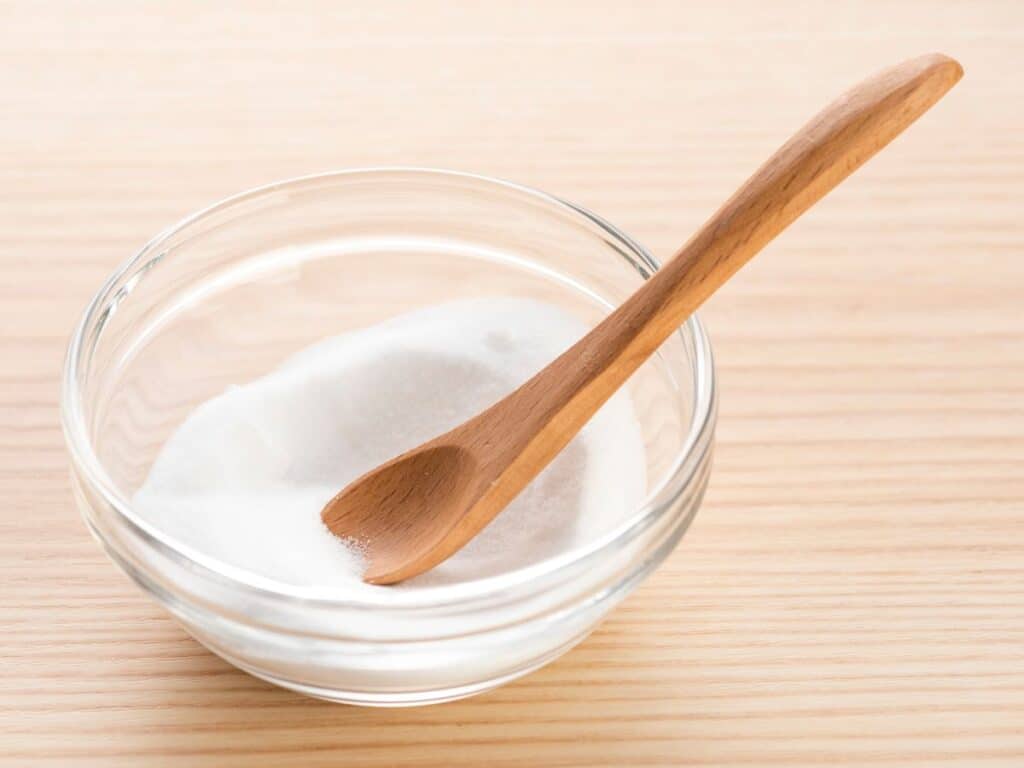
This is also another terrific option for removing limescale from the kettle. Citric acid is effective against limescale due to its acidic state, which quickly softens and dissolves it.
Citric acid is cheap, and you can buy it from any convenience or DIY shop near you.
To start off, heat about ¾ full of clean water to the boiling point, then add two tablespoons of citric acid and stir it. Allow this solution to sit for 30 minutes as it works on the limescale.
Afterward, discard this solution and scrub the limescale with a brush to clear out all the residues of limescale.
Make sure to thoroughly rinse the kettle to remove all the citric acid residue.
Using Lemon Juice
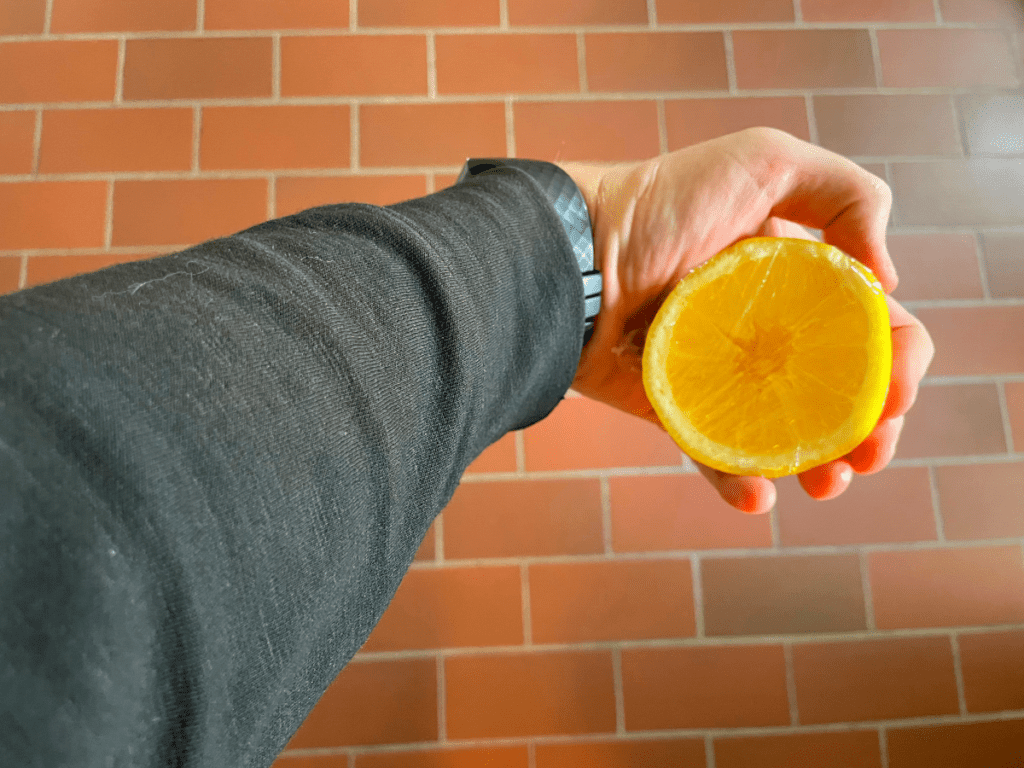
Lemon has been used in removing stains in items around our homes where it is used as a mild bleach due to its acidity.
It is these same acidic properties that make it effective in removing limescale from the kettle.
Start by cutting the lemon into two halves, and put them into the kettle before adding enough water to cover the stained sections.
Next, heat the mixture to boil, let it sit for one hour as it works on the limescale, and also cool down.
Afterward, pour the mixture and rinse the kettle thoroughly to make it ready for use.
Removing Limescale With Baking Soda
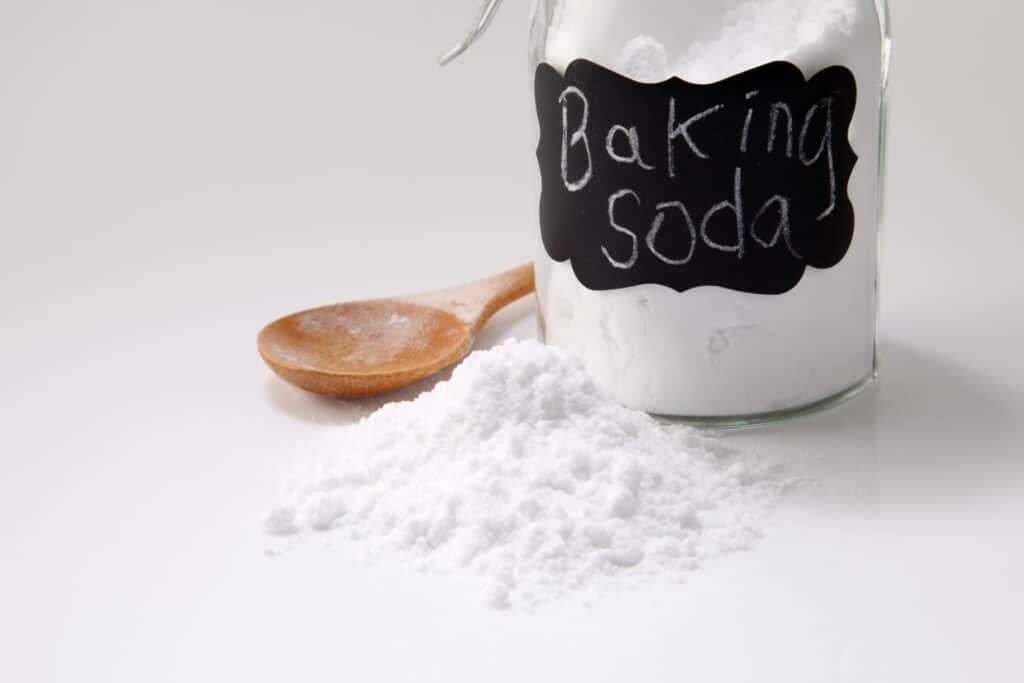
Also known as bicarbonate of soda, baking soda is mainly known for its uses in the kitchen. But besides that, baking soda is also a potent cleaning agent that you can use to remove lime from your kettle.
To use this method, add one tablespoon of baking soda to ¾ full of the kettle, heat to the boiling point, and allow it to sit for 30 minutes. You can pour out this solution and check out if the limescale is gone.
If not, you can use a toothbrush or a scrubbing pad to remove any uncleared limescale stains. Next, fill the kettle to the same level and heat to the boiling point to clean out baking soda residues as well.
Remove It With Coke
Coke, a renowned refreshment drink, doesn’t only quench your thirst. Due to its acidity, coke has the same cleaning power as the other cleaning agents we discussed earlier.
Fill your kettle with up to ¾ of your kettle with the coke, boil it and wait for an hour. You can then pour out the solution and put some clean water to scrub it further before rinsing.
Finally, fill the kettle with water and heat it again until it boils to remove the coke residues from it.
Using Commercial Descalers
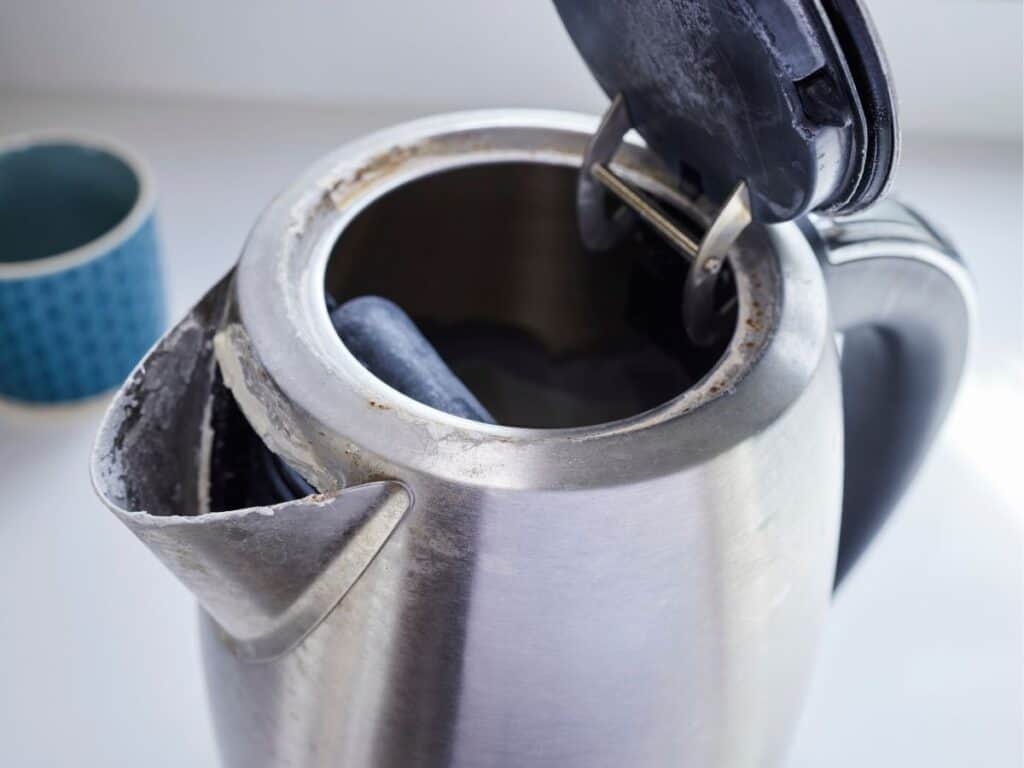
If for whatever reason, you find the homemade solutions too much of a hustle, you might want to opt for ready-made commercial descalers.
These are formulated with the right balance of ingredients and additives to be effective.
Below are a few of the best commercial limescale removers.
Oust Kettle Drop in a Bag

Oust is a fantastic limescale remover that looks like a tea bag. These bags are easy to use, as all you have to do is pop a few of them into the kettle and fill water up to ¾ level.
Next, heat the kettle until the water boils. Allow it to sit for one hour as it works on the limescale before pouring out the water.
For better results, do some scrubbing to dislodge any limescale residue. You can then rinse the kettle several times, and it will be as good as new.
Natruth Limescale Remover

Natruth is a simple yet effective commercial limescale remover that is presented in tablet form, making it a convenient one to use.
It is formulated with citric acid as one of the main ingredients, making it quite effective in limescale dissolution.
Dissolve one tablet in the kettle and heat the solution until it boils. Set it aside for thirty minutes, pour out the water, and rinse the kettle with clean water.
Ecozone Kettle Descaler

Ecozone is an eco-friendly kettle limescale remover that works like magic. They are so called because they are manufactured in compliance with all the environmental and safety requirements.
For that reason, they are PETA approved for their ethical practices, one of which is to avoid testing on animals. And for convenience, it is packed in easy-to-use sachets.
Boil water, then pour in the content of one sachet and wait for 30 minutes for its potency to work on the limescale. Pour out the water and rinse the kettle, and all the limescale will have gone.
Caffetto Liquid Organic Descaler

Caffetto is a limescale remover that can clean limescale on many surfaces with excellent results.
Other than on your kettle, it can also be used to clean many other items, including espresso machines, water tanks, or urns.
Boil water and add about 20mls of Caffetto limescale remover. Then wait for the cleaning agent to work on the limescale overnight.
Next, pour out the solution and give the kettle a scrub before rinsing several times to avoid a strange taste.
How to Prevent Limescale Build-up
While we have discussed some helpful ways of removing limescale from the kettle, once stuck, it is a tough nut to crack. Hence it is more sensible to prevent or reduce its deposition.
Here are a few tips for doing this.
Do Not Store Boiled Water in the Kettle
Letting unused water sit in the kettle for a long time allows time for minerals to form deposits on the kettle. The solution is to heat only the water you need for the current time.
Alternatively, you can store the remaining water elsewhere, but never in the kettle.
Use Descaling Balls

As the name suggests, descaling balls are round steel wool balls that can help in preventing limescale. These work differently from the other descalers we’ve discussed above.
Descaler balls work by scraping the kettle while washing to prevent the continuous limescale buildup.
Just add some water and dish soap, and swirl them around every time you clean your kettle, and it will work perfectly.
Use Water Softener
As we found out earlier hard water is the culprit in the limescale buildup. The most prudent way is to use hard water softeners.
There are several homemade as well as commercial water softeners that can solve this problem.
Use Water Filtration Service

Investing in an effective water filtration system is one of the most prudent ways of preventing limescale on your kettle. An efficient filtration system can sieve off limescale mineral ions from the source.
I wrote extensively about water filters in my guide to the best washing machines for hard water. Tap here to go directly to that section.
How to Clean the Outside of Your Kettle
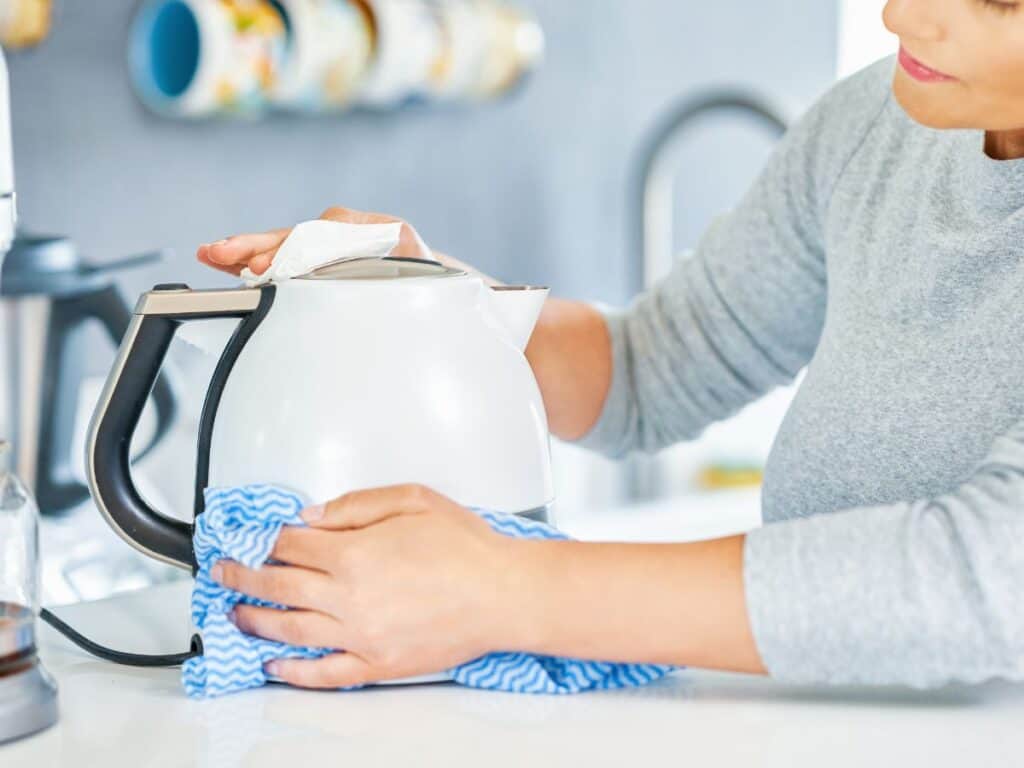
So far, we’ve been concentrating on removing the limescale from the inside of the kettle. But how do we keep the kettle clean on the outside as well?
Not properly cleaning the outside can result in permanent grime staining as well.
Here is how to do it.
Spray some antiseptic detergent cleaners on a microfiber and use it to wipe the exterior of the kettle with it.
For even better results, you can pour a few drops of olive oil on a cloth and use it to buff the stainless steel exterior, resulting in a shiny finish.
While at it, do not forget the spout, which is often neglected. If not regularly and properly cleaned for a long time, this can result in permanent stains.
General and Safety Limescale Removing Tips
Disconnect Power While Cleaning
Never soak with water the sections that connect to the main socket when cleaning the kettle. The worst mistake is to dip the kettle in water.
This is quite risky and should be avoided to prevent electric shocks, fire, or damage to the device.
Watch Out to Avoid Getting Scalded
The cleaning solution in the kettle is usually quite hot. As such, let it settle until it cools sufficiently to avoid getting scalded.
Also remember, looks can be deceiving.
It is possible for a solution that looks cooled inside the kettle to be searing hot, as all do not cool down at the same rate. So the best thing is to take extra caution when handling it.
Give It Some Scrubbing
While using the above methods is effective in removing limescale, some stuck stains might require scrubbing to remove them completely.
Use an appropriate scrubber such as saucepan scrubbers for better results.
Polish the Interior and Exterior With Olive Oil
Pour some olive oil on a cloth and use it to wipe the stainless steel kettle exterior. This will restore its sheen and make it look newer.
Frequently Asked Questions
What Happens if You Use the Kettle With Limescale?
Limescale is not known to have any harmful health effects. So no worries if you drink beverages prepared in such a kettle.
However, limescale may alter the taste to a not-so-desirable one. Also, it may contain flaky chalky unpleasant substances floating on it.
Can You Get Rid of Thick Limescale on the Kettle?
It is possible to remove thick, tough limescale from the kettle. Just pour some vinegar or lemon juice on the limescale and wait for 30 minutes to soften it.
After ten minutes, add some of the cleaning solutions on a cloth and use it to scrub on the softened limescale until it is gone.
How Often Should You Remove Limescale From Your Kettle?
The longer the limescale has taken to accumulate on the kettle, the harder it is to remove. So the sooner you remove it, the easier it is to do it.
Ideally, you should clean the limescale every four weeks to prevent it from accumulating.
I also wrote a guide on removing limescale from washing machines which may interest you to read next.

I’m an expert wardrobe organizer and a bit of a clean freak. I created this website and its YouTube channel to share practical guides about laundry and organizing. My teachings have been featured in multiple large news publications, and I’ve self-published two wardrobe organizing books and an entire course on the subject.

